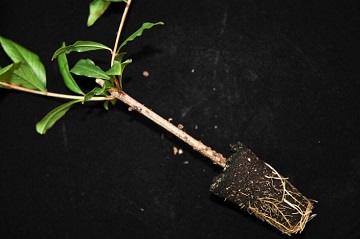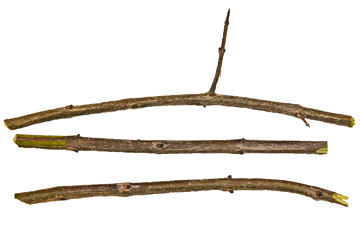Pomegranate
Propagation and Pruning
Propagation
Pomegranates
are easily propagated either by seed or as cuttings. There
are
many ways described on the internet to propagate
pomegranates. The following information is based on our limited, but growing
experience with propagation in the UF project, reputable pomegranate
experiences shared by others in Florida and elsewhere and a compilation
of valid research studies. 1
Seed. Propagation by seed is generally less desirable than by cuttings when
trying to preserve the characteristics of a plant that produces fruit
on a perennial tree or shrub like pomegranate. Seeds (with
a few exceptions) are a sexual means of propagation; cuttings are an
asexual or vegetative method. The importance of that
distinction
is the reason seeds are often not used to propagate perennial fruit
plants. Seeds, as a sexual method, can lead to genetic
diversity
and variability among seedlings. Cuttings reproduce the plant
without variability and are true-to-type. The plants
propagated
from a single, original plant by asexual methods constitute a clone.
That means that the resulting plants will essentially be identical to
the original or mother plant.
Seedling juvenility. Another often overlooked aspect of seed propagation is
juvenility. Seeds are a stage in the normal sexual life cycle
of
a plant like pomegranate. Therefore, when seeds are sown,
they
must grow for a while before they are capable of producing
flowers. That period of time is called the juvenile
period. When the juvenile period ends, the plant begins to produce flowers and
is once again capable of undergoing sexual reproduction by producing a
fruit with the enclosed seeds. The length of the juvenile
period
varies form months to years among different plants. Experience
with pomegranate indicates it is relatively short (i.e., 1-2 years);
however, seedling pomegranates may have a longer period to flowering
than cuttings as with many perennial fruit crops.
1
Germinating
Seeds/Transplanting Seedlings
Seed extraction and preparation. Remember: the seed is the entire entity removed from the
fruit. It consists of the embryo and the aril together. So, should
the
aril be removed?
Freshly extracted seeds can be sown, but the germination percentage may
be lower than for seeds treated as follows.
• Remove the aril. Simply roll the seeds in a paper towel to
break
the aril and absorb the fluid. Thoroughly rinse the seeds.
• Dry the seeds 30 minutes to an hour or two, or longer.
• Refrigerate for up to a few weeks before sowing.
Washed,
dried and stored seeds apparently tend to germinate better because the
combined effect of the treatments is to remove germination inhibitors
and maybe satisfy a dormancy requirement.
Seeds will germinate okay in just about any common potting medium as
long as the seeds are kept moist and warm after sowing. Sow
the
seeds about ½ to 1 inch deep.
Warm temperatures
(75 to 85°F) are important for germination.
Seed pre-sowing treatment
may be beneficial. We are presently experimenting with an
idea
brought to us by a cooperator who dusted freshly extracted seeds with a
commercial root-enhancement product commonly available in home and
garden stores. It may be important that the product contain
at
least 1000 ppm indole-3-butyric acid (IBA). Also, dusting the
seeds with a fungicide like Banrot®WP may help prevent any losses
during storage and germination.
Transplant the seedlings
when they are about 4 to 6 inches tall.
Expectations: According to experience in pomegranate breeding, seedlings have
flowered within one year with substantial flowering over the next year
or so.
Cuttings. It is usually recommended that cuttings be harvested when the plant is
dormant, i.e., during the winter. Our experience in
cooperation
with a commercial mist-bed propagator is that cuttings taken at any
time of the year will root. What may be more important is the
diameter of the cutting.
1
Rooting
Cuttings: UF/CREC Experience
1
Type. Semi-hardwood to hardwood.
Size. Quill to pencil diameter or about 1/8 to ¼ inch caliper and 4 to 6
inches or longer in length. We have successfully rooted
cuttings
3/8 inches in diameter.
Time
of harvest. Cuttings can be harvested at any
time of year in Florida.
Source. Take cuttings judiciously. Remove branches to thin out the
canopy. Suckers or sprouts from the base of the plant are an
excellent source of cuttings especially when harvested in the winter
when they are dormant.
Rooting
medium. Cuttings can be successfully rooted in just about any medium from sand
to a peat mixture that drains well without becoming soggy. Commonly used media contain some peat and other ingredients like
perlite.
Rooting
container. The type or size of the container is not very important, thus, anything
available will probably work just fine. Cuttings can also be
rooted directly in place as described below.
Handling/preparation. We have not re-cut the stem or made a fresh angled cut. Also,
it
is not clear whether it is critical to cut the stem in the internode
region or close to a node, but having at least one node in the medium
is recommended.
Cutting one end
of the stem at an angle is helpful to distinguish the top from the
bottom of the cutting.
Furthermore, our propagator has been using a knife to scrape the bark
before sticking the cuttings rooting medium.
Fig. 1. Each
cutting is about 6 inches long, the diameter of a thin pencil and has
3-4 nodes. The base of the cuttings is to the left and was cut about
midway between nodes, or in the middle of the internode. The top
cutting has square-cut ends; the middle cutting has the bark scraped to
reveal the underlying green color in 4 places around the circumference;
the bottom cutting has an angle cut at the base. The base of each
cutting would be dipped in a growth regular (hormone) compound from the
tip to just below the first node then stuck in rooting medium with that
node just below the surface of the medium.
Environmental conditions. The trick is to control moisture so that the base of the cutting is not
constantly soaking wet.
The same temperature range for germinating seeds is suitable for
rooting.
Our commercial propagator uses a mist bed with misting for 10 seconds
every 20 minutes in a peat-heavy rooting medium.
Also, as cuttings are usually rooted leafless, they can be in the dark
if that is the only warm place available. After they strike
roots
and begin to produce new leaves, move them to a place with light or
sunshine.
Rooting hormone. Are hormone dips essential? Probably not, but dipping or
dusting
cuttings with a commonly available rooting hormone powder or solution
containing indole-3-butryic acid (IBA) helps insure good
rooting.
Our propagator uses a dip in Hormodin 2, a compound containing 0.3% IBA
or 3000 ppm.
Expectations:
Rooting will take place under warm conditions in 4 to 8 weeks (Fig. 2).

Fig.
2. Plant development of a 6-inch, thin, pencil-sized cutting
after 6 weeks in a mist bed. The bark of the cutting was
scraped
and dusted with indole-3-butryic acid growth regulator prior to
sticking. Excellent rooting is evident along with shoot development
illustrating the positioning of the nodes opposite each other.
Our
experience has been that the percentage varies according to cultivar
and size of cutting with 60% to 85% common and the larger diameter
cuttings rooting better than the smaller sized ones.
Cuttings taken from young seedling plants may not root as well as those
harvested from older, more mature plants.
1
Rooting Cuttings: Procedure Used at The
National Clonal Germplasm Repository pdf
Pruning
Trees
tend toward a bushy habit with many suckers arising from the root and
crown area. Tree-type plants can be produced by allowing only one trunk
to develop. Additional suckers should be removed frequently around main
trunk(s).
Prune to produce stocky, compact framework in the
first 2 years of growth. Cut trees back to 60-75 cm (2-2.5 ft.) at
planting and develop three to five symmetrically spaced scaffold limbs
by pinching back new shoots, the lowest at least 20-25 cm (8-10 in.)
from the ground. Shorten branches to 3/5 of their length during the
winter following planting. Remove interfering branches and sprouts
leaving two or three shoots per scaffold branch. 2
Light, annual
pruning of established trees encourages production of good quality
fruit. Remove dead or damaged wood during late winter months. Remove
sprouts and suckers as they appear. 2
Back to
Pomegranate Page
|

